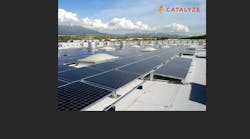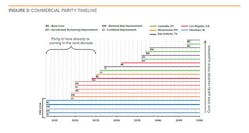Keep your eye on the electric power generation market. Things are going to start getting weird.
There is a lot of talk right now about distributed generation and its potential to upend the legacy business models of electric utilities in the United States and around the world. If the predictions come to pass — and given the direction of global trends examined in some recent studies, it now seems inevitable that they will in some form or another— electrical distributors may find themselves in a position to expand their offerings to residential, commercial, industrial and institutional markets in a rather significant way.
Imagine being able to sell and support not just the components of a building’s electrical systems from the meter inward, but the whole chain from generation to load. If not for you, then for the next generation of electrical distribution leaders, this will almost certainly be part of their reality. The future may be mom & pop power.
Why would someone want to take on the headaches of care and feeding for their own power supplies? The drivers are many:
Reliability. As the U.S. electrical grid continues to age (we were the first, therefore ours is the oldest), many people have raised reliability concerns despite its century of solid performance. There is a constant need for upgrades and a constant flow of advances bringing opportunities to rebuild with smart-grid technologies such as smart meters, distribution management and demand response systems and sensors everywhere. It’s a costly undertaking. Despite many high-profile test installations of smart-grid technologies, any random interruption of power raises users’ interest in an alternative.
Culture. The rise in environmental concern over the past decade or so has driven more demand for renewables, in the form of large solar and wind power projects, but also promotion of rooftop solar. Integrating variable renewable power sources such as wind and solar onto the grid creates stability problems for a system built to direct electrons in one direction, but people who desire renewable or low-carbon sources of power would like a system that accommodates those goals. Disputes over whether small power producers should be allowed or even incentivized to sell their power back onto the grid through net-metering is one of the key distributed generation battlegrounds and will be so for years to come.
Technology. R&D focused on better, more efficient ways of generating and storing electric power has been advancing in every direction at a frantic pace. The focus is on base materials, flow batteries, alternative fuels and piezoelectric generators, just to name a few examples, and they all expand the menu of technologies that could be applied to distributed generation.
Economics. Solar module prices have fallen dramatically over the past three years. Electric vehicle development is driving demand for batteries that could also be suitable for on-site power storage, which is leading to lower costs due to economies of scale.
Meanwhile, the push for greater energy efficiency in all kinds of systems, from high-performance LEED and net-zero buildings to EnergyStar toasters to LED lighting retrofits, has pushed the power-demand curve flat or even tilted it downward in some markets. That means those costs for upgrading the grid must be spread across fewer kWh, pushing up the remaining users’ electric bills and making distributed generation more attractive. This is the nexus of what some refer to as the utilities’ death spiral.
Someday is closer than it looks
A recent study by the Rocky Mountain Institute (RMI), Boulder, Colo., “The Economics of Grid Defection,” put some numbers to the trends and found that the day when distributed generation technologies become cost-competitive with grid-supplied power is not that far off at all.
Focusing its research on solar power backed by a battery as the most viable current “utility-in-a-box” technology, RMI found commercial electric customers in Hawaii (using solar-plus-battery with a diesel backup generator) may already have passed that inflection point. More important, RMI’s analysis showed that for customers representing many billions of dollars in annual electric power consumption — in areas including California and New York — solar-plus-battery systems will reach grid-parity even in the study’s most conservative scenario by 2031.
Three other scenarios charted by the RMI authors involving faster (but not outlandish) advances in solar module and battery technologies, energy efficiency and both together bring the date of grid-parity forward dramatically. In the most accelerated case, grid parity comes to commercial users in New York and Los Angeles within the next decade.
The solar-plus-storage story is at the forefront of the discussion because of its simplicity and rapidly improving economics, but many other technologies for providing small-scale power are also under intensive development. Fuel cells are an important one, used in some high-profile microgrid systems and the new World Trade Center. Gas-fed microturbines take advantage of declining prices for natural gas. Geothermal and wind are applicable and economic in some geographic settings. Any combination can supply a microgrid, and with combined heat and power (CHP) systems they can provide heat, too. GE recently announced a major effort to expand its distributed generation offerings focused on gas-fed micro-turbines.
The implications for utilities has been cast as a death spiral, at least for utilities’ legacy business models where their revenues are tied to power consumption. This won’t be a surprise for the utilities, whose research organizations, including the Edison Electric Institute and the Electric Power Research Institute, have produced white papers examining the combined forces driving distributed generation and laying out a new path forward for utilities by integrating distributed generation into the grid.
It is clear some will resist the pace of change by challenging net-metering incentives and contesting some customers’ moves to disconnect from the grid, while others reorganize their business models around the new reality.
Distribution’s role
Distributors already established in the solar market have a significant advantage in the roll-out of solar-plus-battery systems as the inflection point arrives for growing numbers of electric power customers.
Kelly Boyd, principal of ElectroRep, San Francisco, an independent manufacturers’ rep agency very active in the solar market, says distributors who invested heavily up-front to build specialized solar power offerings have a durable advantage. The rest of the distribution community was left handling “balance of system” parts.
But the biggest opportunities are still to come. Distributors who want to pursue this opportunity must get up to speed. Storage devices — primarily lithium-ion batteries at this point — will be critical components and there’s no telling who will emerge as the preferred brand. Tesla Motors’ proposed Gigafactory would make it a contender. As electric vehicles further penetrate the transportation market and the first generation of EVs reaches the end of its road life, the steady supply of used batteries coming out of those junked cars may find a second life in grid or off-grid storage systems.
Keep an eye also on bulk-power renewable energy projects in developing markets. Renewables projects in developing countries have a critical need for safe, reliable and scalable storage because they need power sooner than they can build new transmission and distribution infrastructure. Lots of people are working on a solution, which will then get rolled out in the developed world for distributed generation. This adoption will be accelerated by government policies such as California’s new mandates for grid-scale energy storage.
Distributors need to get in front of manufacturers developing the batteries, fuel cells, ancillary equipment, and tell their story, focusing strongly on project management expertise and experience providing services such as kitting, logistics, onsite supplies management and so forth. Relating it to services such as energy audits and financing for energy-efficient lighting retrofits, or project management for switchgear installations, should also pique their interest.
“I think distributors have to really sell their switchgear groups — the way they bid switchgear packages and the way they have project management teams,” Boyd says. “Many of the solar energy people don’t understand distributors offer those kinds of services.”
A distributed-power environment also will mean a larger variety of customers looking for maintenance, repairs, upgrades and technical support — and most of these buyers are your customers already. Many in the industry are looking for an Apple of power to rise from this and put its brand on utility-in-a-box systems. Whoever gets in the customer’s head first as providing a good solution will have the advantage.
For now, look for signs that distributed generation is starting to take off in your markets — keep an eye on regulatory changes, test installations, disputes over utility rates and net-metering, and track local costs for solar panels, batteries, smart inverters, as well as incumbent fuels — natural gas, coal, nuclear — and above all, the rates charged for electricity and the fixed costs added into that bill.
As the point of grid-parity moves closer in your market, you will be well positioned to become the supplier of choice for local homes and businesses who want control of their own power.
Note: the printed version of this story had the name of Kelly Boyd's agency wrong. We regret the error.











